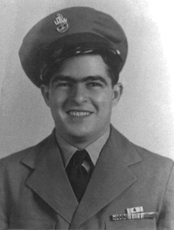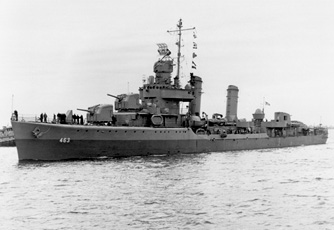

Robert Fred Miller
Chief Water Tender, USS Corry (DD-463)
The mine detonated just below
the keel between the forward fireroom and the forward engine room, killing
or injuring most of the people in those spaces, breaking the destroyer's
keel, jamming her rudder hard right. The pressure from the in-rushing sea
filling the forward engine room caused its after bulkhead to buckle, causing
the after fireroom to begin flooding. I, then one of the Chief Water
Tenders, who had been at his battle station in the after fireroom since
2400, as we cruised off the Normandy coast.
At dawn, the landing craft began going ashore. We were using our 5-inch main batteries in a duel with the shore batteries trying to prevent them firing at transports and landing craft. The shore batteries were also, at times, firing at us. You could hear the shrapnel striking the sides of our ship as they exploded on hitting the water but, that had so far, not caused any serious danger to us in the after fireroom.
The mine had exploded under us at about 0630, and the shock stung the soles of our feet, but nothing serious. All managed to keep their feet and attended to their duties. The lights went out from damage to the generators in the forward engine room. We continued operating our plant under emergency lighting.
All communications from our area had been damaged, and at the time we really did not know where the main damage was, except the forward (starboard) main engine had stopped. We also had no knowledge that we were steaming in a circle caused by the jammed rudder.
Up to this point, both of our boilers were still in operating condition. Eventually we began to lose the feed water supply to our boilers, due to the apparent loss of Booster Feed Water from the after engine room. Eventually, we did shut down No. 4 boiler, hoping it would help keep No. 3 boiler operating.
At this point, one of the men manning the front of No. 3 boiler noticed water coming over the floor plates. I sent my First Class Water Tender, Henry Passek, to attempt to put the bilge pump on, to try and keep the flooding under control. It was necessary for him to climb over the port drive shaft, as the bilge pump was located on the forward starboard side of the boiler room.
He came running back out saying, "We've got no more bilge pumps. Just a hole with water pouring in like Niagara Falls, from the buckled bulkhead." This was the first we knew about that.
Anyway, I then told everyone to hold on as long as we could. Eventually the water level got about knee deep. I told the fireman on No. 3 boiler to shut down the burners. Just to keep down any panic, I ordered the men to finish shutting equipment down in an orderly, routine manner. Then, as everything was orderly, I gave the order to abandon the fireroom and proceed to their abandon ship stations, and I was the last man out.
A comical thing happened at that time. I had just the night before been given a brand new foul weather jacket and left the fireroom without it. I looked back down the hatch, hoping to have time to salvage it, but no luck; the water was already right at the bottom of the hatch.
Another comical thing happened after we abandoned ship. The situation I was in charge of had only a net, with flotation for the men to hang on to. It turned out that one of my men was deathly afraid of drowning, so I instructed all of us to bundle the net up in the center so he could get on top and be mostly out of the water. On going to battle stations at midnight, I had put on a brand new pair of shoes, black Tom McCans that I'd paid 20+ dollars for just before we'd left Norfolk and hoped to save them. I reached underwater, took off one shoe and handed it to him and asked him to hang onto it. I then reached underwater to take off the other shoe. Before I could get it off, the guy on top of the net dropped the shoe he had in his hand and down to the bottom of the bay it went. I just laughed then and threw the other shoe over my head. So much for the brand new shoes I'd only worn since midnight.
For a shore while before we'd actually abandoned ship, everyone had gotten busy putting the caps on tight on the powder containers. Our 5-inch ammunition came in two parts. One was the casing containing the powder, and the second part was the projectile. The casing cans had a watertight cover. As they had their caps back on and empty, we threw them over the side as additional flotation devices.
Eventually, I and many others grabbed two of these cans and put one under each arm for flotation. We all did have life belts, but I doubt if many even thought to use them. I know I didn't. The rafts, whaleboat, and flotation nets, plus the empty powder cans gave everyone plenty of flotation.
When we abandoned ship, the tide was going inshore, and, of course, we all swam against the tide, not relishing the thought of a POW camp. Since the ship sank upright in only about 40 feet of water, most of the upper superstructure was still visible to the shore batteries, and they kept firing at it. Consequently, more men were killed in the water than from the mine.
Eventually, the tide did
change and we were swept seaward of the ship. Then it was possible for other
ships nearby to safely come in and pick us up. The USS Fitch, one of
our sister ships, picked me up. We eventually wound up back in England late
that night, and later in the fall of 1944 to the good old USA.
Robert Fred Miller
Chief Water Tender
USS Corry (DD-463)